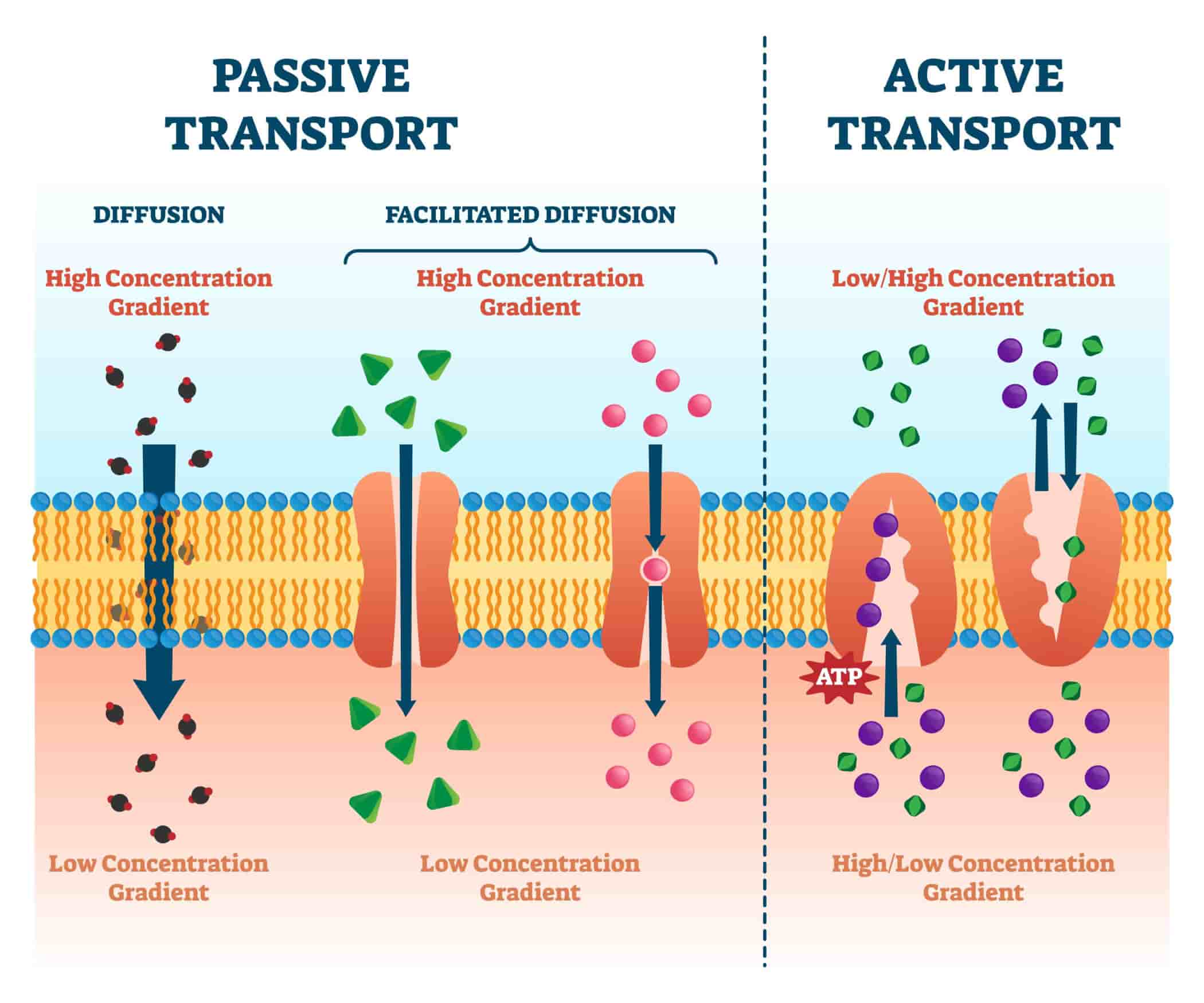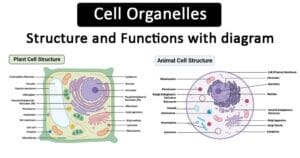Active and passive transport are two primary biological processes essential for delivering nutrients, water, oxygen, and other vital molecules to cells, as well as for removing waste products.
- Both active and passive transport serve the same purpose but operate differently.
- Active transport requires chemical energy because it involves moving biochemicals from areas of lower concentration to areas of higher concentration.
- In contrast, passive transport moves biochemicals from areas of high concentration to areas of low concentration, thus not requiring energy.

Key differences (active transport vs passive transport)
| S.N. | Character | Active Transport | Passive Transport |
| 1. | Definition | The movement of molecules across the cell membrane, pumping the molecules against the concentration gradient using ATP (energy) is called Active transport. | The movement of molecules within and across the cell membrane and thus transporting it through the concentration gradient, without using ATP (energy) is called Passive transport. |
| 2. | Energy requirement | Energy is required which is in the form of ATP. | No energy is required. |
| 3. | Concentration Gradient | The movement of molecules is from low concentration to high concentration which means they move against the concentration gradient. | The movement of molecules is from high concentration to low concentration, which means they move along the concentration gradient. |
| 4. | Direction of movement | With the use of ATP, it pumps the molecules upwards. | In this, the molecules are moved downwards. |
| 5. | Carrier Protein or Pumps | Active transport requires carrier proteins. | In passive transport carrier proteins are not involved. However, in facilitated diffusion certain channels are present which utilize no energy. |
| 6. | Involvement of matrix or permeases | Matrix or permeases of the membrane are not involved. | It takes place through matrix/channels/permeases. |
| 7. | Efficiency of the Process | It is a rapid process. | It is comparatively a slow process. |
| 8. | Principle of Working | Active transport allows molecules to pass the cell membrane, disrupting the equilibrium established by the diffusion. | A dynamic equilibrium of water, nutrients, gasses, and wastes is maintained by passive transport Between cytosol and extracellular environment. |
| 9. | Directionality | Occurs in one direction. | Bidirectional process. |
| 10. | Process type | Active transport is a vital process. | Passive Transport is a physical process. |
| 11. | Selectivity | It is highly selective. | It is partly non-selective |
| 12. | Effect of Temperature | Affected by temperature. | Not affected by temperature. |
| 13. | Effect of Oxygen Level | This process reduces or stops as the level of oxygen content is reduced. | This process is not affected by the oxygen content. |
| 14. | Effect of metabolic inhibitors | Metabolic inhibitors stop the active transport. | Metabolic inhibitors do not influence passive transport. |
| 15. | Molecules Transported | Macromolecules like proteins, carbohydrate (sugars), lipids, large cell are few of the materials which are transported by this way. | Oxygen, monosaccharides, water, carbon dioxide, lipids are the few soluble materials which are being transported through this way. |
| 16. | Types | Active transport is classified into two categories, like primary active transport and secondary active transport. Endocytosis, cell membrane/sodium-potassium pump & exocytosis | Passive transport is classified into four categories like osmosis, diffusion, facilitated diffusion, and filtration. |
| 17. | Functions | Though the function of both types of transport is to carry ions and molecules, separately active transport is used to carry through the cell membrane. | It is used to maintain the equilibrium, within and outside the cell of nutrients, water and gases, etc. |
| 18. | Examples | Examples of active transport include a sodium pump, glucose selection in the intestines, and the uptake of mineral ions by plant roots. | Passive transport occurs in the kidneys and the liver, and in the alveoli of the lungs when they exchange oxygen and carbon dioxide. |
Active and Passive Transport Comparison:
- Definition:
- Active Transport: ATP, energy, concentration gradient, cell membrane, pumping molecules.
- Passive Transport: No energy, concentration gradient, cell membrane, molecule movement.
- Energy Requirement:
- Active Transport: ATP, energy required.
- Passive Transport: No energy.
- Concentration Gradient:
- Active Transport: Low to high concentration, against gradient.
- Passive Transport: High to low concentration, along gradient.
- Direction of Movement:
- Active Transport: Upwards, ATP usage.
- Passive Transport: Downwards.
- Carrier Protein or Pumps:
- Active Transport: Carrier proteins.
- Passive Transport: No carrier proteins, facilitated diffusion channels.
- Matrix or Permeases Involvement:
- Active Transport: No matrix/permeases.
- Passive Transport: Matrix/channels/permeases involved.
- Efficiency of Process:
- Active Transport: Rapid process.
- Passive Transport: Slow process.
- Principle of Working:
- Active Transport: Disrupts equilibrium, cell membrane passage.
- Passive Transport: Maintains equilibrium, cytosol-extracellular environment.
- Directionality:
- Active Transport: One direction.
- Passive Transport: Bidirectional.
- Process Type:
- Active Transport: Vital process.
- Passive Transport: Physical process.
- Selectivity:
- Active Transport: Highly selective.
- Passive Transport: Partly non-selective.
- Effect of Temperature:
- Active Transport: Affected by temperature.
- Passive Transport: Not affected by temperature.
- Effect of Oxygen Level:
- Active Transport: Reduced or stopped by low oxygen.
- Passive Transport: Not affected by oxygen content.
- Effect of Metabolic Inhibitors:
- Active Transport: Stopped by metabolic inhibitors.
- Passive Transport: Not influenced by metabolic inhibitors.
- Molecules Transported:
- Active Transport: Macromolecules, proteins, carbohydrates, lipids, large cells.
- Passive Transport: Oxygen, monosaccharides, water, carbon dioxide, lipids.
- Types:
- Active Transport: Primary active transport, secondary active transport, endocytosis, sodium-potassium pump, exocytosis.
- Passive Transport: Osmosis, diffusion, facilitated diffusion, filtration.
- Functions:
- Active Transport: Carries ions/molecules through cell membrane.
- Passive Transport: Maintains equilibrium of nutrients, water, gases.
- Examples:
- Active Transport: Sodium pump, glucose absorption in intestines, mineral ion uptake by plant roots.
- Passive Transport: Kidney and liver function, alveoli gas exchange (oxygen and carbon dioxide).










